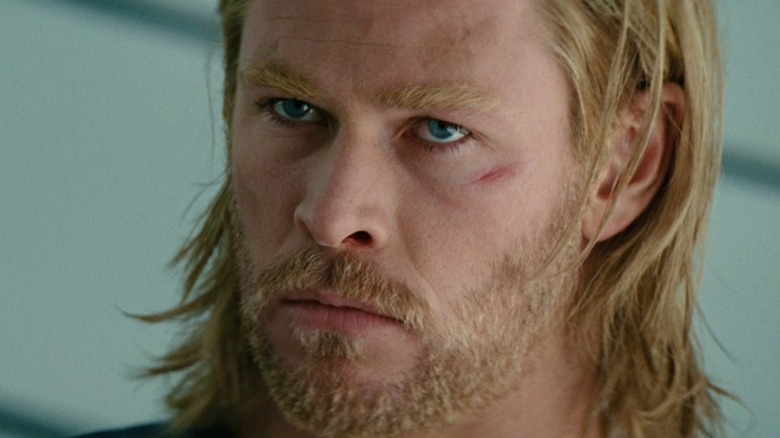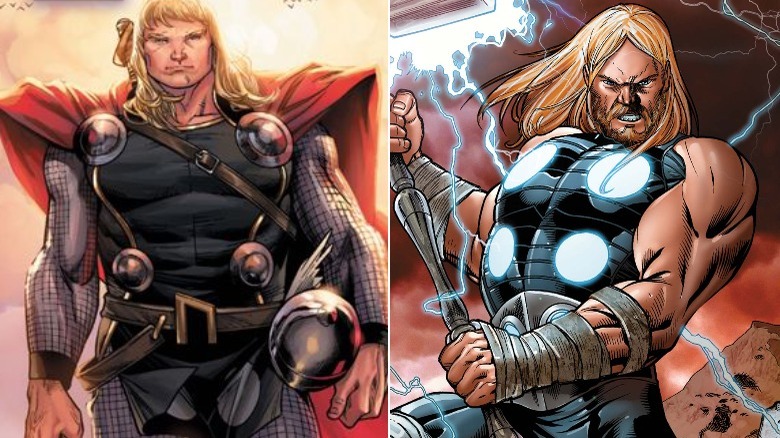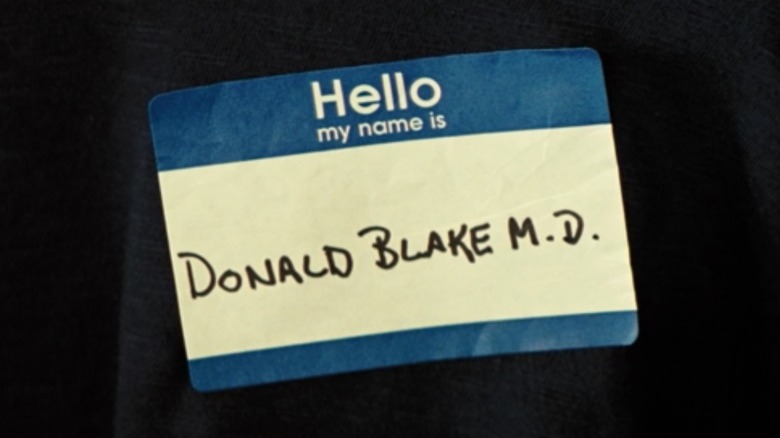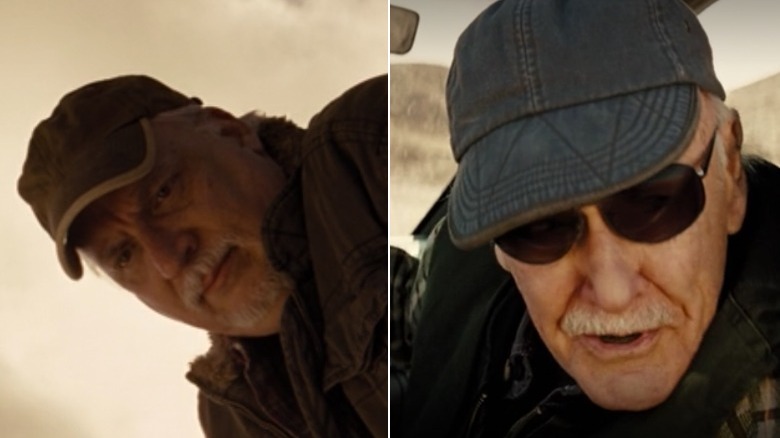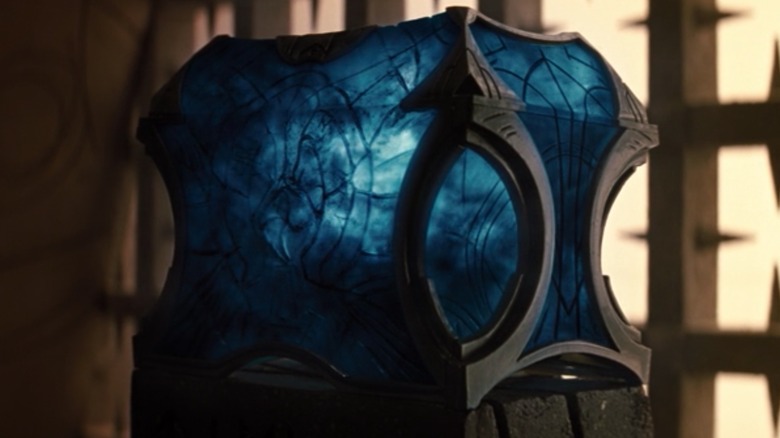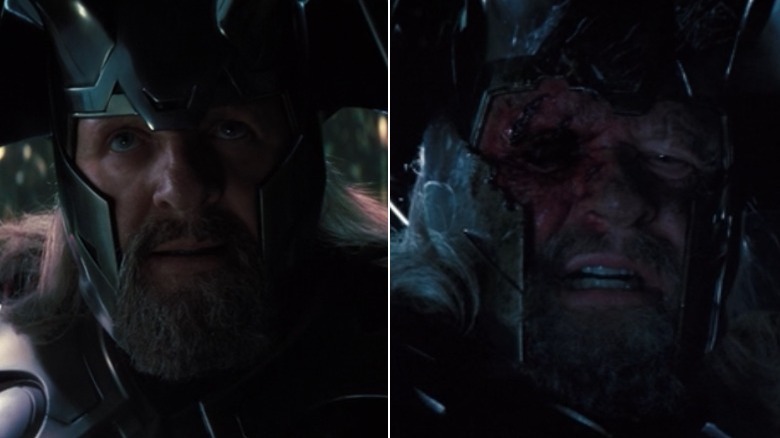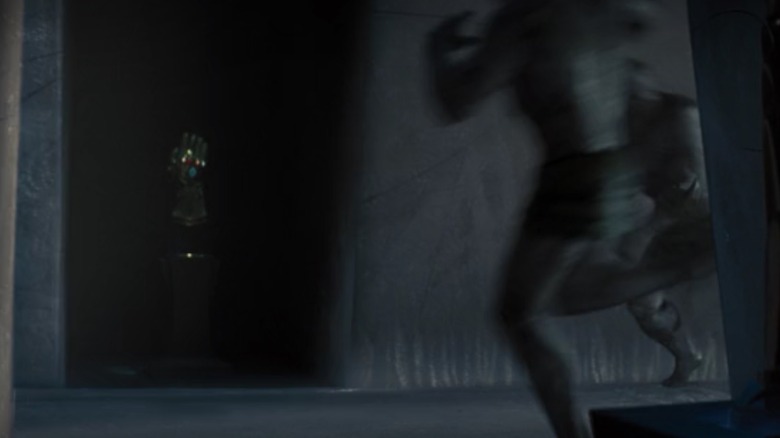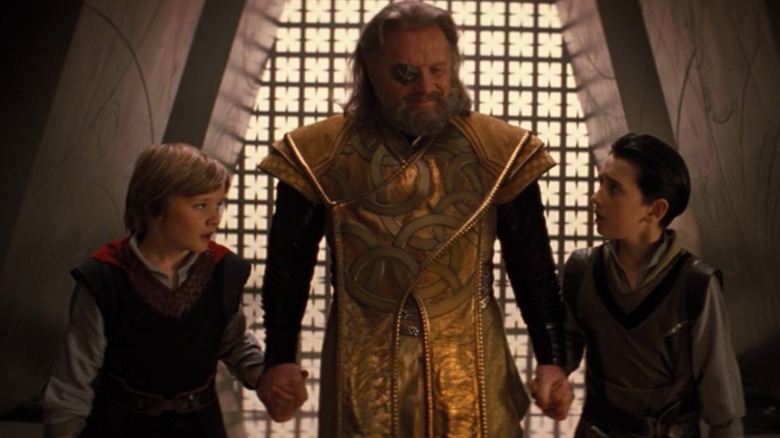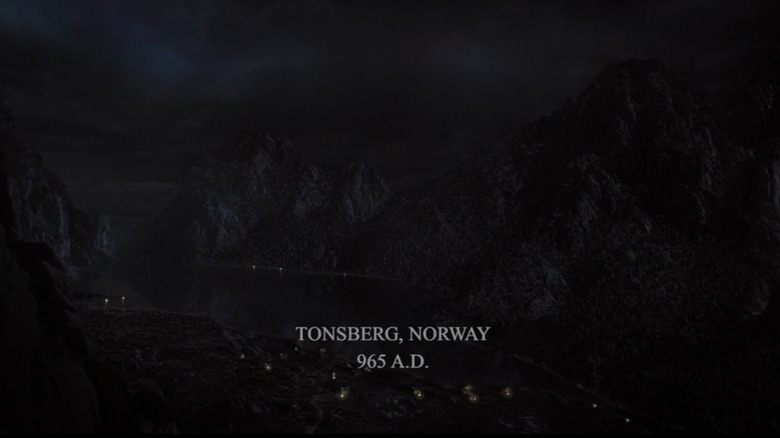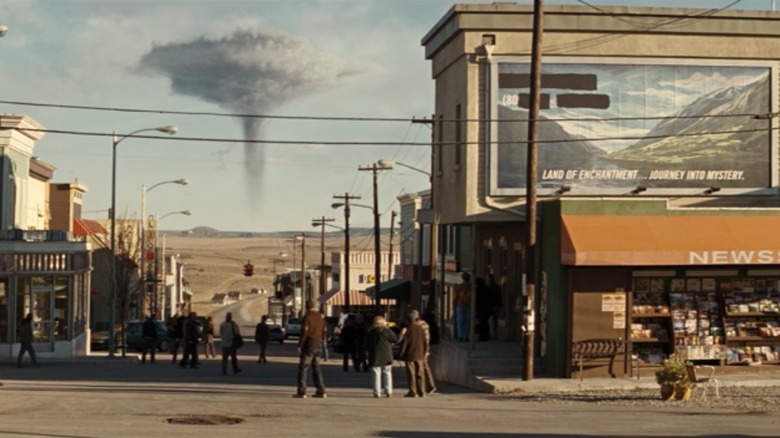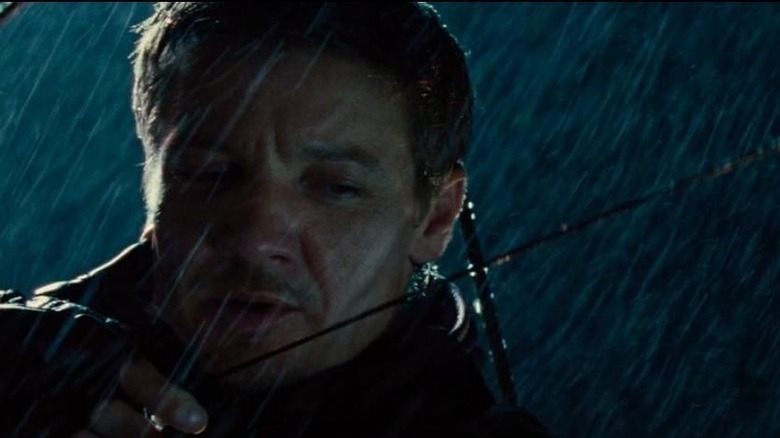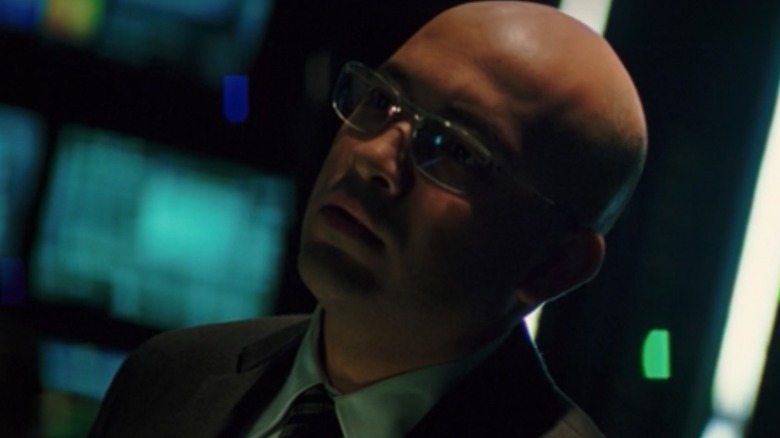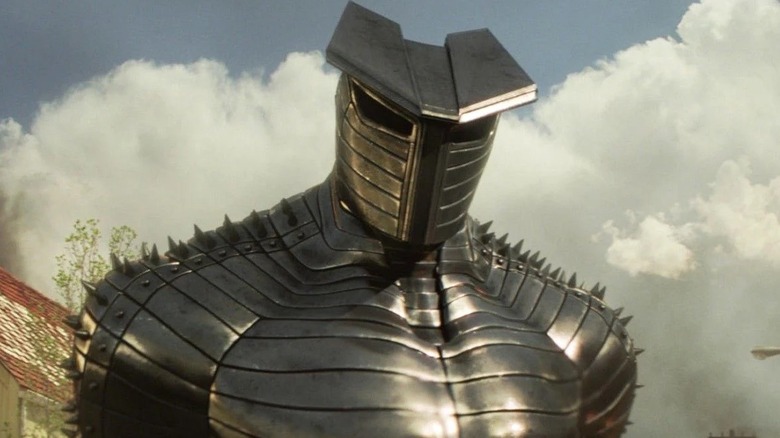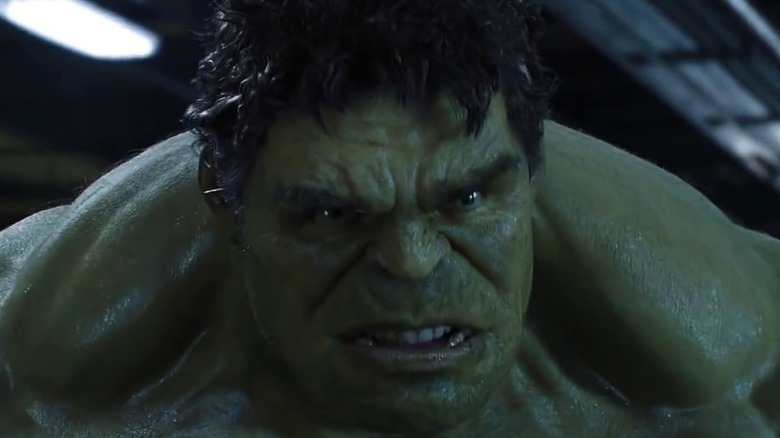Easter Eggs You Missed In Thor
Debuting in 2011, "Thor" marked just the fourth entry in what is now known as the Marvel Cinematic Universe. "Iron Man" repulsor-beamed the door down in 2008 followed by the now mostly ignored "Incredible Hulk" that same year and "Iron Man 2" in 2010. At that point, the Robert Downey Jr. films had done quite well earning just under $586 million and shy of $624 million worldwide respectively. However, "Incredible Hulk" brought in a still-healthy, but far less impressive $264 million. Though the company had a variety of plans in the works for the future leading to "The Avengers," "Thor" remained an important test to see how audiences would respond to not only a character without much familiarity to the general public, but also an actor who had not done much by that point in Chris Hemsworth.
Much like with Jon Favreau helming the "Iron Man" films and Louis Leterrier on "Incredible Hulk," Marvel Studios took a swing by bringing in noted Shakespearean actor and director Kenneth Branagh, who also happened to be a big fan of the source material. The result is a film that not only explores what it means to be truly worthy of the power at one's disposal and the complex relationships between parents and children, but also includes a great deal of Easter eggs for fans of the Thor comics and beyond!
This Thor contains multitudes
When Stan Lee and Jack Kirby got to work building the Marvel Comics Universe in the early 1960s, just about every hero they came up with had a secret identity. So, when Thor debuted in 1962's "Journey Into Mystery" #83, he came in the form of a human doctor stuck in a cave who found a walking stick. When he tapped that gnarled piece of wood on the ground he became Thor, the Asgardian god of Thunder. It was honestly confusing at first whether the doc just took on Thor's powers or also his personality. As the character evolved, that whole part of his life was dropped for the more streamlined adventures of the warrior Asgardian, which we see in the film.
However, there are also a few other elements at play. In 2000, Marvel launched a publishing imprint called Ultimate Marvel, which took characters who had been around for decades and start them over fresh with updated and sometimes totally new origins. In the case of Thor, who debuted in "Ultimates" #4 it was unclear whether he truly was the god of thunder or an escaped mental patient, which is the vibe Natalie Portman's Dr. Jane Foster is catching for a large chunk of "Thor."
Hello My Name Is ... Donald Blake
Speaking of Thor's secret identity, it gets called out twice in the film. When the Asgardian gets banished to Midgard (Earth), he gets hit by Foster's car. She, Dr. Erik Selvig (Stellan Skarsgård) and Darcy Lewis (Kat Dennings) take him back to their research headquarters in town. To make him feel more comfortable, Foster offers Thor a shirt with one of those Hello My Name Is... stickers, with "Donald Blake, MD" still stuck to it. She notes that this is an ex-boyfriend of hers. Later, when Selvig goes to get Thor out of SHIELD custody, he refers to him as Don Blake, saying that he was a member of their research team who got drunk and rowdy after the secret organization came in and stole all their equipment.
The aforementioned alter ego for Thor in the comics was none other than Manhattan physician, Dr. Donald Blake. He had a limp which allowed for the mystical cane to not be much of an issue. He also employed a nurse by the name of Jane Foster, who had quite the crush on Thor, but did not think highly of her boss. The two remained linked for a time, but Odin never quite cared for the idea of his son being with a mortal, so the relationship fell apart. Foster went away for quite some time wherein and got married, earned her doctorate, and discovered she had cancer. This is when Thor re-entered her life. Not long after, he lost his worthy-ness and she became Thor.
Not one, but two creator cameos
The major theme of the film sees Thor proving that he is worthy of wielding both the naturally superior power of an Asgardian and also the mystical hammer known as Mjolnir. To that end, Odin (Anthony Hopkins) strips his son of his natural abilities, as well as the hammer, putting a spell on it so that only someone worthy can wield it before sending both to Earth. While Thor gets to know Jane and her crew, the humans around the New Mexican town of Puente Antiguo come across the weapon and try to lift the strange object.
The first to come across Mjolnir in the desert is none other than J. Michael Straczynski. After getting his start writing for animation on shows like "He-Man and the Masters of the Universe," he moved on to create "Babylon 5" and made the jump over to comics. In 2007, he launched a new "Thor" comic series with artist Olivier Coipel that not only established a brand new look for the character — one reflected in the film — but also a storyline that began with Mjolnir sitting in a desert town with a bunch of people trying to lift it! Of course, this version of Thor would never have existed without his original writer, Stan Lee, who also shows up, this time as the driver of a pickup truck who tries to drag Mjolnir, away only to lose the back half of his vehicle. Later on, in the scene where Thor smashes the coffee mug in the diner, you can see that same truck driving by without its backside.
That blue box is a major mystical weapon
Early in the film, Laufey, the king of the Frost Giants, wields a box with a blue light that unleashes the power of the winter storm. Odin ultimately defeats him and takes not just the weapon, but also Laufey's son, Loki. Held in Asgard's vault, the artifact referred to as the Casket was sought by Ice Giant infiltrators, which interrupt Thor's coronation. Incensed by the attack and goaded on by Loki (Tom Hiddleston), Thor decided to lead an unsanctioned attack on their home, Jotunheim. This act not only got Thor banished, but began Loki down the road to find out about his own origins. Later, he uses the box in his own scheme to gain power.
In the comics, this box is fully known as the Casket (or cask) of Ancient Winters and it debuted in 1984's "Thor" #346, which is part of a legendary run written and drawn by Walt Simonson. Interestingly, the Frost Giants did not play into that story, but two other villains did: Malekith and Surtur, who would go on to appear in "Thor: The Dark World" and "Thor: Ragnarok" respectively. The comic story did result in the Cask being unleashed on Earth, freezing major parts of the realm, including New York City, though Thor and the Avengers ultimately saved the day.
Odin loses his eye
Going way back to the early days of the comics Odin, like Nick Fury, has worn an eye patch. In fact, one of his nicknames is simply Odin One-Eye. A variety of stories have been given for the missing oculus over the years. One says that he gave up his eye to Yggdrasil the World Tree for knowledge, and another says he gave it up to avoid Ragnarok. Upon seeing Anthony Hopkins as Odin, fans began to wonder if the story would be told at some point.
They didn't have to wait long for the answer, as it comes pretty early in the film, but things are happening so quickly that you might have missed it. During the battle with the Frost Giants, we first see Odin with both eyeballs. Then, King Laufey makes a spiked ice ball and hurls it at one of his opponents, hitting him in the face. Later, Odin is seen with a bleeding wound where his right eye once was. He begins wearing a patch sometime after that.
The Asgardian vault is filled with interesting artifacts
As "Thor" moves along, the Casket is secured inside Odin's vault on Asgard. During the aforementioned raid by the Frost Giants, as well as other scenes inside the building, viewers got a look at some interesting items, many of which Odin collected over his long reign to keep his people safe. Early on, we even see that Mjolnir is kept there. Though the items were not clearly labeled — at least in English — some did look familiar. There was a great deal of speculation if one was the Eye of Agamotto, most commonly associated with Doctor Strange, who had not been introduced yet.
One significant item that was only briefly glimpsed, but definitely noticed by fans was a particular golden gauntlet with six different collared stones adorning it. Thanks to "Avengers: Infinity War," the movie-going public knows that to be a representation of the Infinity Gauntlet holding the Infinity Stones. As Hela clearly displayed in "Thor: Ragnarok," that proved to be a fake. She also claimed that other items in there were also fraudulent which, was probably a way to explain away what was clearly meant to be a fun Easter egg instead of a major plot point. Thor returns here in "Ragnarok" for the Eternal Flame, which features heavily into the end of that film.
A pair of kings
During another early part of the film, after we've seen the war between the Asgardians and the Frost Giants, Odin shows his sons Thor and Loki the Casket of Ancient Winters in the vault. It turns out that the All-Father's voiceover was actually a speech to his children about the responsibility that they may one day have to carry as potential rulers. "Only one of you can ascend to the throne. But both of you were born to be king," Odin says.
That line seems like standard royalty stuff at first, but it's true on more than one level. As the film goes on, Loki learns that he is not only truly a Frost Giant, but also the son of King Laufey himself. With that in mind, the line takes on extra meaning in that Loki was born to take over a throne — just the one on Jotunheim as opposed to that of Asgardian.
Tønsberg through time
"Captain America: The First Avenger" came out just a few months after "Thor," in July of 2011. That World War II-era film revolves around the transformation of Steve Rogers into the title character, as well as his mission to bring down the Red Skull who is in possession of the Tesseract. During the post credit sequence of "Thor," Nick Fury is already in possession of the artifact, which teases a bit of the upcoming film.
In yet another connection, this film features a battle between Frost Giants and Asgardians back in 965 A.D. in Tønsberg, Norway. In "Captain America: The First Avenger," this is the same place that Red Skull uncovers the Tesseract in 1942, which he uses to give his own group, Hydra, a major power boost. But that's not all for this town. After losing so many of their citizens between "Thor: Ragnarok" and "Avengers: Infinity War," the Asgardians set up a new home on Earth in, you guessed it, Tønsberg — even renaming it New Asgard. As seen in "Avengers: Endgame," Thor would spend a good deal of time there eating and playing video games, while Valkyrie kept the place running.
Puente Antiguo is full of references
The fictional town of Puente Antiguo features more than a few nods to the comics and other fun Easter eggs hidden within city limits. For one thing, the name itself translates to "ancient bridge" from Spanish. So, while on Earth, Thor finds himself keeping "Ancient Bridge" safe, but then on Asgard he has to destroy the Rainbow Bridge (also called the Bifrost) to save his home.
But that's not all. There's a curved sign on a water tower that declares the city "Home of the Vikings." A more prominently featured billboard on the side of a building displays a beautiful mountain scene with the tagline "Land of Enchantment ... Journey Into Mystery." This is something of a double whammy because the first part is actually New Mexico's state motto while the second half is the title of the comic book title that Thor debuted. "Journey into Mystery" had been an anthology title before Thor's introduction, and morphed into "Thor" with #126 in 1966.
Hawkeye takes aim
It doesn't take long for SHIELD to swoop in, chase away the locals and set up their own facility to perform research on Mjolnir. In addition to a gaggle of scientists, Agent Phil Coulson (Clark Gregg) also brings along a number of highly trained agents to keep the area secure. When Thor shows up to get his weapon back, his presence does not remain a secret for long. In an effort to get a better handle on the situation, Coulson orders an agent by the name of Barton to take his compact bow up on a raised platform so he can get a solid visual in the rain. This marks the very first appearance of Jeremy Renner as Hakweye, the human archer who would go on to become a major player in "The Avengers."
Barton winds up as a pawn of Loki very early in "Avengers" and does not get control of himself again until after he helps attack the SHIELD helicarrier. Hawkeye and Thor don't actually come together in their right minds until the Chitauri attack towards the end where they both want to go after Loki for what he's done to them.
A wolf in sheep's clothing
Clint Barton might be the most prominent SHIELD debut in "Thor," but there's one more in there who would also go on to have a significant impact on the MCU over the next several years — and you barely know he's there. Agent Coulson might be in charge of the hammer investigation, but he's aided by Agent Jasper Sitwell (Maximiliano Hernández). Though he seems like just another agent, this man proves to be a major threat down the line.
In the fifth season of "Agents of SHIELD," the episode "Rise and Shine" revealed that Sitwell had been indoctrinated in Hydra's dogma as a teenager. He went on to join SHIELD as part of a plan to infiltrate the organization. He succeeded, rising in the ranks and working alongside Phil Coulson and even Nick Fury. As shown in "Avengers: Endgame," he secures Loki's scepter for his Hydra overlords at the end of "Avengers," which explains how it fell into Baron Von Strucker's possession by "Avengers: Age of Ultron." He also appeared all throughout "Agents of SHIELD" before the truth was ultimately revealed in "Captain America: The Winter Soldier," in which Sitwell finally reveals his true colors as an agent of Hydra. Even though they failed to sustain control, Hydra's action still lead to the downfall of SHIELD, no small feat indeed.
Is it one of Stark's?
At the end of the film, Loki has assumed the throne of Asgard and sends a walking tank called the Destroyer to take out his brother and his allies. Instead of being smited, though, Thor manages to prove his goodness so that Mjolnir will respond to his call. Before that, SHIELD was investigating the area where the hulking armored figure appears. Upon seeing it, Sitwell asks, "Is it one of Stark's?" Coulson responds, "I don't know. That guy never tells me anything."
It's actually a solid question considering that, by this point in the MCU chronology, Stark had built several different armors in his very public career as Iron Man. In fact, the Destroyer does look somewhat similar to the very first one he cobbled together in "Iron Man," as they are both large and silver.
In the comics, the Destroyer is an incredibly powerful, nearly indestructible battle automaton of sorts made from uru, the same metal as Thor's hammer. As in the film, it does not have sentience, but simply follows orders, obliterating what it's commanded to. Loki has used his magic to manipulate it in the past and has even driven it from the inside, as seen in the "Asgardians of the Galaxy" miniseries. During the Asgardian-fueled "Fear Itself" story, Tony Stark built weapons to fend off the godlike attackers, one of which was an armor inspired by the Destroyer, so Sitwell wasn't too far off.
Dr. Selvig might know Bruce Banner
Jane Foster's group manages to figure out the missing link in their research when Thor literally falls out of the sky and they begin to learn more about the Nine Realms. While trying to figure out what all of that really means, SHIELD rolls in and takes all of their equipment and findings. Later on, while the two are talking about the whole thing, Selvig remembers hearing about SHIELD before saying, "I knew this scientist. A pioneer in gamma radiation. SHIELD showed up and he wasn't heard from again."
Of course, when you hear "gamma," your mind immediately goes to the Hulk. Selvig's story doesn't quite line up with what viewers saw in "Incredible Hulk," with Ed Norton's Bruce Banner getting tricked into creating a new version of the Super Soldier Serum by Thaddeus Ross. Once he became the Hulk, SHIELD got involved in trying to stop him, but it's an understandable mix-up, especially given the fact that the story was probably passed along via hearsay. By the end of "Thor," Selvig has gone on to work for SHIELD, examining the Tesseract which lead to his encounter with Loki, Thor's brother and later the newly formed Avengers — which includes Bruce Banner.
